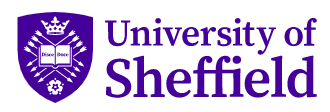University of Sheffield Library (Established 1879)
Dates
- Existence: Established 1879
Biography
The story of the development of the Library from its unsatisfactory origins in Firth College (1879-1896) and University College (1897-1904) is told in Arthur W. Chapman's The story of a modern university (University of Sheffield and Oxford University Press, 1955): "Of all the developments in the years before the first world war first place must be given to that of the Library. We have already seen how unsatisfactory was almost everything connected with the Library in University College; how meagre the collection of books (about 10,000 volumes in 1905), and how badly they were housed."
As the fledgling University moved to its new location in Western Bank in 1905 the Library was housed in the General Lecture Room, there not being enough money available to provide a purpose-built Library. The inauguration of the new era was made possible by the generous offer by William Edgar Allen (a member of the University Council from 1905 to 1915) to provide £10,000 to establish a purpose-built Library, and this momentous news was proclaimed on the opening day of the new University. E.M. Gibbs, the University Architect, designed the distinctive octagonal shape of the new building, in the attractive neo-gothic style of the other structures in the Western Bank complex, constructed of mellow red-brick and sandstone. The new Library was located beside, and indeed impinged in a small way upon, the public Weston Park, a trespass which aroused opposition in some quarters of the City (though the University gave an equivalent amount of land to the Park in compensation).
On 26th April 1909 the new building was honoured by the visit of the Prince of Wales (later H.M. King George V) who, with the Princess, performed the opening ceremony. At the Degree Congregation in Firth Hall which took place as part of the celebrations Edgar Allen was awarded the honorary degree of Doctor of Letters. The new Library was one of the earliest specially designed university libraries in the country, having seats for 100 readers and shelving for 20,000 books, and with potential stack space for 60,000 further volumes. Inevitably, as time went on, this apparently generous storage space would be filled.
Sir Charles Harding Firth, the first Lecturer in Modern History in the old Firth College before he became Regius Professor of Modern History at Oxford, was a most generous donor of books from his large personal collection to the new Library, but towards the end of the 1920s it became known that he intended to donate many more volumes from his collection. A grant from the Town Trustees enabled the University to convert the large General Lecture Theatre into a Reading Room with capacity for a further 20,000 volumes specifically to house the Firth Collection (which today contributes a major part of the Rare Book Collection) and other historical works. This extension was completed in 1931.
With the growth of student numbers over the following decades, and especially following the Second World War, it eventually became necessary to replace the old Edgar Allen Library, and in the late 1950s a new purpose-built structure was planned and built beside what was, up to that point, a public thoroughfare. As befitted the modern post-war era the new Library, as well as having greatly enhanced capacity, was radically different in design from its predecessor, being resolutely rectangular, the exterior of plate glass with stone facings and the interior strongly constructed of reinforced concrete and steel, with marble stairways and features. The University and Library were honoured once more, this time by having an "eminent man of letters", T.S. Eliot, to perform the opening ceremony on 12th May 1959. A higher degree ceremony conducted within the main Reading room of the new building saw the award of honorary degrees to both T.S. Eliot and to Dr. Stanley Peyton, the Librarian, among other notables. This distinctive new structure has since been given the accolade of Grade 2 listed building status. However, it has to be recognised that, designed for an age before the Robbins Report, which ushered in an unprecedented expansion epitomised by the new universities of the 1960s, it in turn experienced problems in coping with the many changing demands placed upon it. The development of branch libraries and in particular of the Information Commons, opened in 2007, has helped to relieve some of the pressure on the Western Bank Library.
List of Librarians:
1893-1897 Professor Alfred Denny (Honorary)
1897-1907 Professor George Charles Moore Smith (Honorary)
1907-1911 Thomas Loveday
1911-1940 Arthur Percy Hunt
1941-1956 Sidney Augustus Peyton
1956-1974 James Eric Tolson
1974-1985 Colin Kershaw Balmforth
1985-2002 Michael Stewart-Moore Hannon
2003-2015 Martin John Lewis
2015-2020 Anne Horn
2020- Anna Clements (interim Librarian)
Found in 7 Collections and/or Records:
Elmfield Collection
Left Pamphlet Collection
Private Presses Collection
Rare Book Collection
Sheffield Medical Portrait Collection
Photographs and other portraits of medical personnel and institutions associated with Sheffield and its University, along with a small number of related documents.
The collection has been formed from material already held by the Library, both from University records and from donated material.
For further details of this collection please see the box list in the External Documents section below.
Sheffield Newspapers Collection
Sorby Research Institute Collection
A small collection of printed documents relating to the Sorby Research Institute at the University of Sheffield and its experimental work during World War II, and including some other works relating to those principally involved.
For a full listing for this collection please see the External Document Section below.
Additional filters:
- Subject
- Artists' books 1
- Communism 1
- English literature 1
- Glass 1
- Hospitals 1
